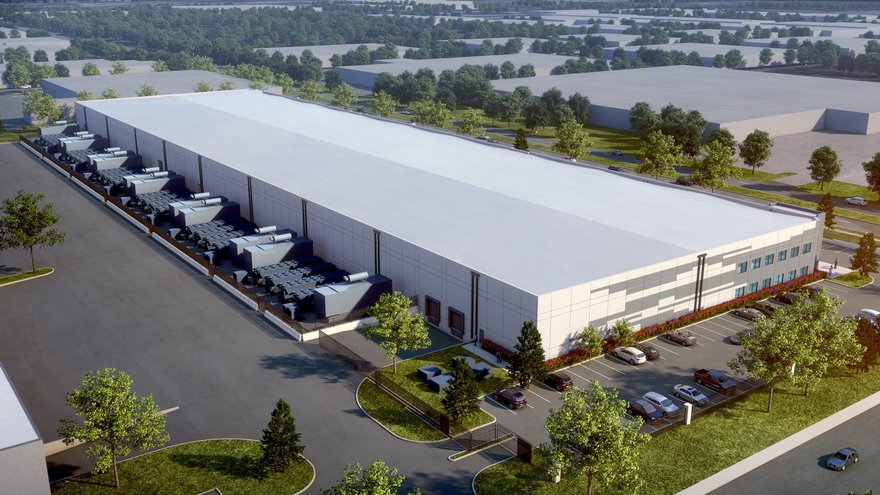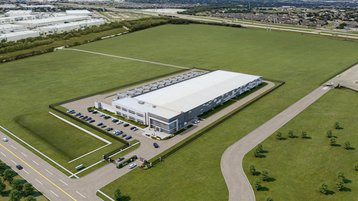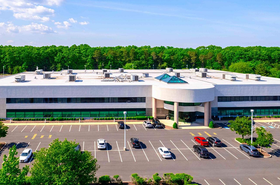For a long while, private equity investors have invested in both digital infrastructure and industrial real estate. Now, logistics-focused real estate firms are beginning to eye up the data center industry as an opportunity for growth.
Despite an e-commerce-driven boom in logistics, these firms are playing both sides and looking to tap into the burgeoning data center sector at the same time in an effort to grow further, even if both sectors might have competing demands for the same sites.
Big players in logistics and industrial real estate, like GLP, Prologis, Segro, and ESR, are looking to data centers, many of them partnering with established data center players to use available facilities and land for both brown- and greenfield developments.
Boom times for both data centers and logistics
Both data centers and logistics are benefitting from the same underlying trends, but competition may be tight.
After pent-up demand due to Covid, the logistics, industrial, and warehouse real estate space is enjoying a boom. In February 2022, Prologis said vacancies are at record lows across the globe and high demand is leading to ‘bidding wars’ and global rent increases of around 15 percent.
Another report from October 2021 said that “space is effectively sold out.” Despite huge amounts of speculative building, pre-lease rates are around 70 percent, the company said.
As with data centers, warehouse construction costs have been driven up by increasing land, material, and labor costs, but that hasn’t stopped many of the large real estate firms in the sector posting healthy profits.
CBRE says that each $1 billion in e-commerce sales needs an additional 1.25 million sq ft (116,000 sq m) of distribution space to support it. Prologis estimates a five percent increase in inventory levels would require an additional 300 million sq ft (28 million sqm) of industrial space, while JLL predicts demand for industrial real estate could rise by an additional 1 billion sq ft (93 million sqm) by 2025.
At the same time, work and personal lives are being increasingly digitized, producing an ever-increasing amount of data, and driving data center demand to record highs. The biggest data center markets in the US absorbed 493MW of capacity in 2021, setting a new record 31 percent higher than the previous record year, according to real estate specialist CBRE. Gartner predicts that the data center market will grow year-over-year through to 2024.
The fact that e-commerce giants AWS, Alibaba, and JD.com are major players in both sectors shows their potentially synergistic nature.
As both industries continue to heat up, this is leading to increased competition for land and power. DCD has previously reported that in major markets where the data centers are historically located close to distribution facilities, rents, and land acquisition costs are being driven up by high demand and low availability.
Earlier this year, a former Speedcast data center in New York was bought for $21 million by a Blackstone-backed logistics firm that plans to demolish the facility to build a new distribution center.
In Staffordshire in the UK, a former Royal Bank of Scotland data center is due to be demolished and replaced with a new warehouse by logistics firm PLP. A former Fidelity Investments data center in Irving, Texas, was last year turned into an industrial space and sold.
Logistics companies want data centers
Despite the e-commerce boom, logistics-focused real estate firms are increasingly eyeing the data center industry as a growth opportunity.
APAC logistics firm Logos last year announced a partnership with Pure Data Centers to develop data centers across Asia Pacific. Logos owns, develops, and leases logistics properties across Australia, China, Singapore, Indonesia, Malaysia, Vietnam, India, and New Zealand. The two companies have announced plans to build a new 20,000 square meter (215,000 sq ft), 20MW data center in Jakarta, Indonesia.
Pure had also been planning a similar move with Panattoni in the UK. The two companies were aiming to develop a three-story, 41,763 sqm (449,500 sq ft) data center due to offer up to 50MW of capacity on the site where the logistics firm had already started developing warehouse space. The plans were later dropped, though DCD understands this was due to extended timelines around connecting the proposed facility to the power grid.
Hong Kong-based real estate company ESR Cayman, traditionally focused on logistics, has made a number of moves into the data center space since 2021. In April 2021, the firm announced it was buying a data center in Osaka, Japan, which it plans to expand into a 78MW campus. It has since bought a building in Hong Kong to convert into a 40MW data center, saying the expansion was “a natural move” for the company. It went on to acquire ARA Asset Management, including Logos.
Today, the firm’s data center portfolio consists of six owned development assets totaling 260MW across Hong Kong, Osaka, Sydney, Mumbai, Jakarta, and Singapore. In its 2021 annual results, ESR said data centers were a “key strategic focus” for the company going forward.
“With the closing of the ARA acquisition which brings together Logos to form a multi-pronged platform, the enlarged ESR Group has a combined data center pipeline of over 1,200MW of capacity across the region,” the company said.
“E-commerce acceleration and digital transformation will continue to drive demand for logistics infrastructure and data centers.”
Singapore-based logistics real estate firm GLP – a major player with $120 billion in assets and managing more than 75 million square meters of real estate – has been investing in data centers since 2018, and claims that its assets, including those under construction, will deliver about 2,500MW of capacity across China, Japan, Brazil, and Europe upon completion. In 2019, GLP acquired a 60 percent stake in local data center company Cloud-Tripod.
In Spain, logistics-focused real estate firm Renta Corporacion is building a data center in Barcelona, and Merlin is building a number of facilities across the Iberian region.
Last year, US real estate investment firm PRP said it was diversifying away from office properties and had set a goal of spending $2 billion acquiring logistics and data center properties across the country.
Goodman Group – again largely focused on warehouse and logistics-type real estate – is listed by French data center builder Cap DC as a ‘key partner,' especially in markets such as Frankfurt, Paris, Amsterdam, Milan, and Madrid. The company has also partnered with STT GDC for two facilities in Tokyo, Japan.
Segro is traditionally focused on warehousing and light industrial properties, but also manages the UK’s main data center clusters at its Slough Trading Estate. It recently bought an additional 1 million sq ft of nearby office space it plans to convert and merge into the trading estate as more data center space. Equinix, Virtus, IO, and KKR’s Global Technical Realty all use Segro facilities.
Prologis has partnered with Skybox Datacenters in the US (see Box) and in the UK has previously supplied Virtus with land to develop a data center at Stockley Park outside London that was previously earmarked for a warehouse.
What’s the appeal of partnering?
Amid a competitive market where land and power can be difficult to source in constrained markets, data center operators are always looking for ways to deliver projects in key markets quickly.
“It is quite a difficult market to get into,” says Tom Glover, head of data center transactions, EMEA, JLL. “The significant amount of capex you require to create a data center is still a barrier for a lot of companies despite the amount of capital out there.
“Supply and demand, and speed to market are drivers here. It's difficult to find the right pieces of land and the warehouse logistics marketplace has been for a long time buying land to develop it for industrial logistics uses. Their proposition is ‘we'll get it there quicker than you can probably do it on your own.’”
As a result, he says, large logistics companies offering data center operators potential facilities could create an appealing proposition.
“If you've got a shed that you can bring power into, get the relevant permitting permissions to put a data center there, and the market agrees it's in a good location, it's going to be very appealing for an operator to explore taking a long-term lease on the site.”
“It will never be a short-term lease, because of the amount of investment that the operator will be putting into the ground.”
Glover says he would be surprised if companies like Prologis, Segro, and others don't look at exploring the “cookie-cutter effect” of providing power shells in other markets in the future.
“I can see that still being a business model they will look to benefit from,” he says. In major markets where there is little available land, relying on a partner that has a sizable portfolio of land and potentially convertible facilities could be appealing. However, in Edge or secondary markets where there is less fiber or pressure around available land, such partnerships may not be as necessary.
“In markets with high demand and limited supply, ergo very strong business case, this can be interesting to operators,” says Glover. “In markets with medium demand and a high supply of potential space, I think there's going to be a harder sell unless they have good relationships that they formulated in those major marketplaces.”
Most of the above-mentioned partnerships are focused on using the logistics firms’ landbanks rather than developing facilities in existing buildings, but operators might appreciate the ESG benefits of retrofits. Serverfarm calculates that reused existing buildings can deliver embodied carbon savings of 88 percent compared with the material carbon cost of new projects.
“This offers another string to that bow of development. It would be unwise not to at least consider the idea of potentially
working in a partnership with a logistics provider of sheds,” says Glover. “Anybody that is a landowner of suitable property is going to find that those symbiotic relationships will evolve.”
“Most operators prefer to own their own freehold,” he adds. “And for some operators, [such partnerships] won't be a path that they will ideally go down. But the quid pro quo is they accept that they may not be able to deliver product to a marketplace as quickly as they would like.”







